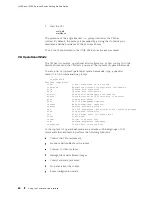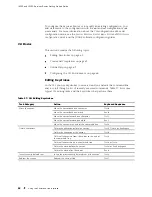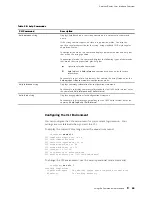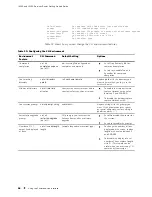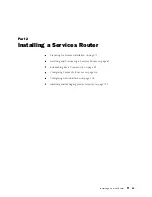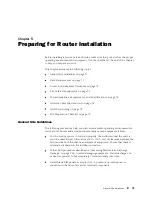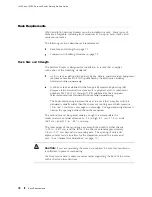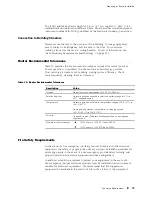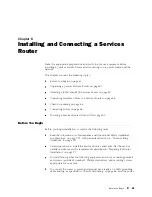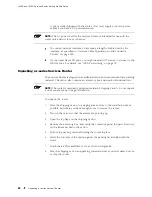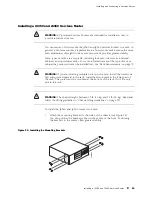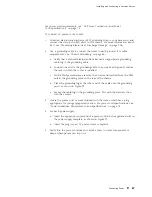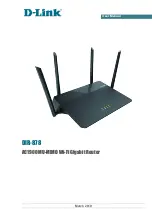
J4350 and J6350 Services Router Getting Started Guide
Rack Requirements
J4350 and J6350 Services Routers must be installed in a rack. Many types of
racks are acceptable, including front-mount racks, four-post (telco) racks, and
center-mount racks.
The following sections describe rack requirements:
Rack Size and Strength on page 72
Connection to Building Structure on page 73
Rack Size and Strength
The Services Router is designed for installation in a rack that complies
with either of the following standards:
A 19-in. rack as defined in Cabinets, Racks, Panels, and Associated Equipment
(document number EIA-310-D) published by the Electronics Industry
Association (
http://www.eia.org
)
A 600-mm rack as defined in the four-part
Equipment Engineering (EE);
European telecommunications standard for equipment practice
(document
numbers ETS 300 119-1 through 119-4) published by the European
Telecommunications Standards Institute (
http://www.etsi.org
)
The horizontal spacing between the rails in a rack that complies with this
standard is usually wider than the router’s mounting ears, which measure
19 in. (48.2 cm) from outer edge to outer edge. Use approved wing devices to
narrow the opening between the rails as required.
The rack rails must be spaced widely enough to accommodate the
router chassis’s external dimensions: 3.4 in high (8.7 cm), 17.4 in. wide
(44.3 cm), and 21.1 in. (53.7 cm) deep.
The outer edges of the mounting ears extend the width of either chassis
to 19 in. (48.2 cm), and the front of the chassis extends approximately
0.5 in. (1.27 cm) beyond the mounting ears. The spacing of rails and
adjacent racks must also allow for the clearances around the router and
rack. (See “General Site Guidelines” on page 71.)
CAUTION:
If you are mounting the router in a cabinet, be sure that ventilation
is sufficient to prevent overheating.
If a front-mount rack is used, we recommend supporting the back of the router
with a shelf or other structure.
72
Rack Requirements
Summary of Contents for J4350
Page 14: ...J4350 and J6350 Services Router Getting Started Guide xiv Table of Contents...
Page 22: ...2 J series Overview...
Page 68: ...J4350 and J6350 Services Router Getting Started Guide 48 Field Replaceable PIMs...
Page 75: ...Services Router User Interface Overview Figure 25 J Web Layout Using the J Web Interface 55...
Page 88: ...J4350 and J6350 Services Router Getting Started Guide 68 Using the Command Line Interface...
Page 90: ...70 Installing a Services Router...
Page 100: ...J4350 and J6350 Services Router Getting Started Guide 80 Site Preparation Checklist...
Page 112: ...J4350 and J6350 Services Router Getting Started Guide 92 Powering a Services Router On and Off...
Page 144: ...J4350 and J6350 Services Router Getting Started Guide 124 Verifying Secure Web Access...
Page 162: ...142 Maintaining Services Router Hardware...
Page 194: ...J4350 and J6350 Services Router Getting Started Guide 174 Troubleshooting Hardware Components...
Page 204: ...184 J series Requirements and Specifications...
Page 220: ...J4350 and J6350 Services Router Getting Started Guide 200 ISDN RJ 45 Connector Pinout...
Page 267: ...Part 5 Index Index 247...
Page 268: ...248 Index...



